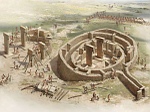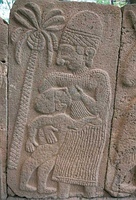Alice's Adventures in Turkey
On October 12 I returned home from the most exciting trip of my life, during which I visited two world-famous Neolithic monuments in England, two medieval English cathedrals, a number of archaeological sites in Turkey, and lived through a Kurdish riot that briefly threatened our tour bus and its passengers. I had been warned that it might not be safe to travel in Southeastern Turkey. Our route was parallel to the Syrian border and at times we were less than 10 miles away from it. The Syrian town of Kobane, currently being attacked by ISIS, was just south of the border.
However, I was determined to visit the site of Gobekli Tepe, the most interesting archaeological site in the world today. I have always been fascinated by the Megalithic monuments built in many places during the Neolithic period. I have visited them in Malta, Brittany, the Orkneys and Ireland, and I began this trip by visiting two more, Stonehenge and Avebury in England. Most of these monumental holy places were constructed between 6,000 and 4,500 years ago; archaeologists have theorized that not until man had developed agriculture and lived in settled communities did he have the extra resources and organizational ability to built these massive temples of stone. We can only guess what rites were performed in these structures.
The discovery of Gobekli Tepe has turned this theory upside down. The site was discovered in 1994 by a German archaeologist, Klaus Schmidt. Using ground penetrating radar, he identified the remains of twenty stone structures. He has only excavated five; they are composed of stone walls and pillars decorated with carvings of animals, many scary: centipedes, lions, boars, spiders, snakes, cranes, vultures and foxes. It has become clear that these date to almost 12,000 years ago and were constructed by hunter gatherers, people whose survived by hunting wild animals and collecting wild grains. These people lived in surrounding villages, up to 60 miles away, and gathered at Gobekli Tepe to construct the temples and to perform rites in the stone circles.
Some of the stone pillars weigh fourteen tons; to assemble the manpower to build these temples and to feed the workers was huge task. The necessity for developing new food sources may have led to the invention of agriculture, since most of the wild grains later domesticated grew near Gobekli Tepe. Men had to work together to build the temples, to hunt for food for the group and to protect the wild crops from animal predators. In this particular case it seems that a powerful mythology motivated these men of the early Neolithic period to work together in ways that eventually led to the life changes we call civilization. Instead of civilization producing religion, shared religious thinking may have preceded and sparked civilization. I began the trip by attending a weekend tour of Stonehenge and Avebury. On Saturday we drove to Avebury, a huge circle composed of a bank and a ditch, lined originally with massive stones called sarsens. The next morning at eight o’clock we arrived at Stonehenge, where our group walked among enormous sarsen pillars for an hour before visiting other related monuments. In recent years it has become clear that the landscape near Stonehenge contains many other ritual structures including round barrows, a long enclosure called a cursus, an avenue to the River Avon and several circles of wood as well as stone.
I had two days to spend before my trip to Turkey, so I added to my list of sacred edifices by visiting Salisbury and Winchester Cathedrals. At each one I took a tour of the cathedral and also attended evensong, a late afternoon service that features choral music. I couldn’t help thinking about how the rituals performed at Stonehenge must have contrasted with what I saw in the medieval cathedrals.
The first site we visited in Turkey was the hilltop fortress-palace of Karatepe, dating to the eighth century B.C. This neo-Hittite site had some stunning stone carvings on the walls of the fortress. In the following days we saw the remains of a fortified Bronze Age citadel called Tilmen Hoyuk, looked at splendid Roman mosaics rescued from the drowned city of Zeugma, took a boat ride on the Euphrates River, walked across the Tigris River on a Roman bridge, explored the city of Sanliurfa, visited a fifth century Syrian Christian church and climbed a mountain top called Nemrut Dagi to see the colossal remains of statues of the ruler Antiochus I and his family, who lived during the first century A.D.
At Gobekli Tepe, we had a two-hour tour of the site by the current director who later came to our hotel for drinks and dinner. He explained more about what we had seen, answered our questions and left us eager to find out what happens next at this remarkable site.
It was on our trip from Sanliurfa to Mardin, our last stop, that we ran into trouble. We had been following the news about the country-wide Kurdish riots that had killed 30 people, but didn’t realize we might become involved until we spotted smoke lazily rising from the roadway ahead of us. As we came closer, we saw that the road was blocked by burning tires and large stones thrown by a group of young men. Our driver wasn’t about to give up. Horn blaring, the bus plunged ahead and reached the other side of the barrier. But we could see more smoke and more young men ahead; the driver had no choice but to turn back on the other side of the divided highway. We sympathized with these young Kurds, who were protesting the unwillingness of the Turkish Army to help their countrymen in Kobane, but we had to reach Mardin that day.
Our bus went back to a gas station beside the road and our tour guides and our driver had a conference. After a few minutes they announced they had learned of a back road across the mountains that would bypass the road closings. No one was sure that our 52 passenger bus could make the journey safely on the small, single-lane roads we were about to travel on, but a local man volunteered to lead us in his car and we set off. Two hours later, after a hair-raising journey, we arrived at Mardin.
On the last day of the trip I experienced severe pain in my left lower leg due, I later learned, to a ruptured Baker’s cyst. The trip home was a nightmare and I was unable to walk for almost a month afterwards. But I still think the trip was worth it.
Website for Gobekli Tepe www.gobeklitepe.info/
Documentary on Gobekli Tepe http://www.youtube.com/




